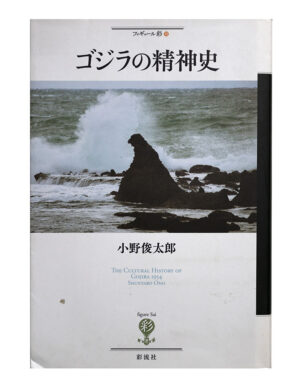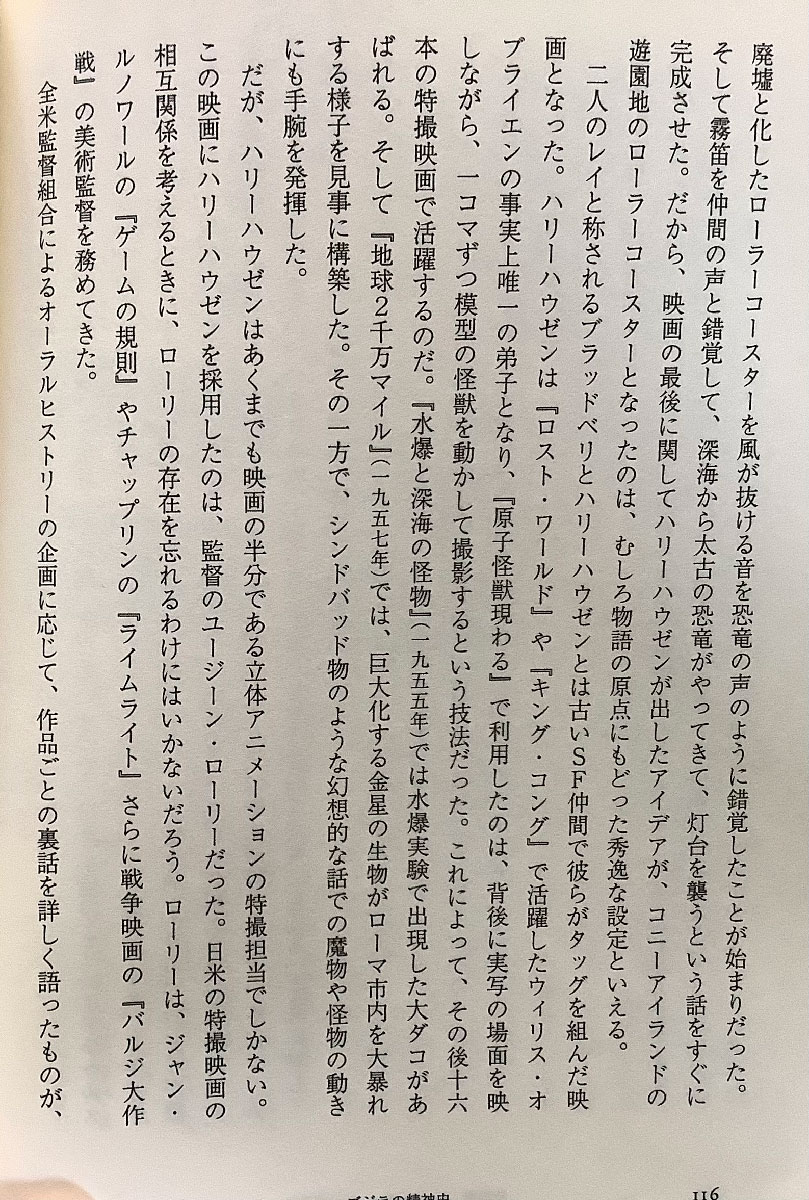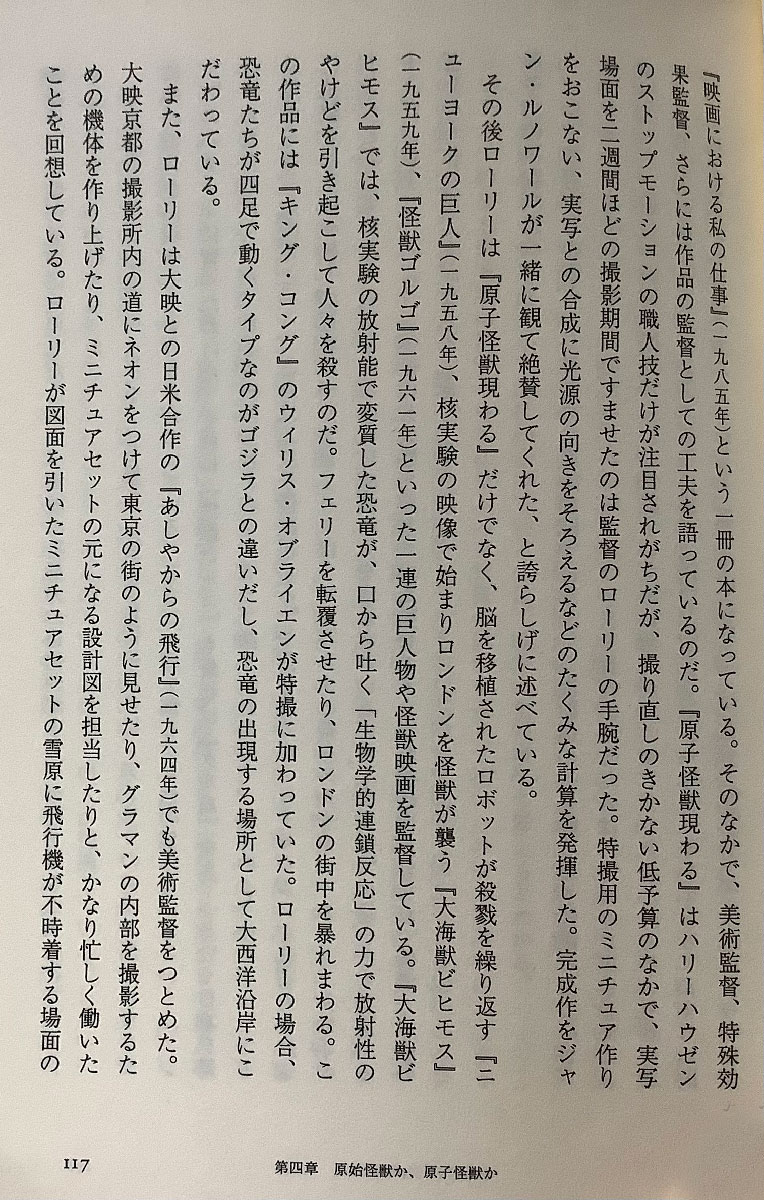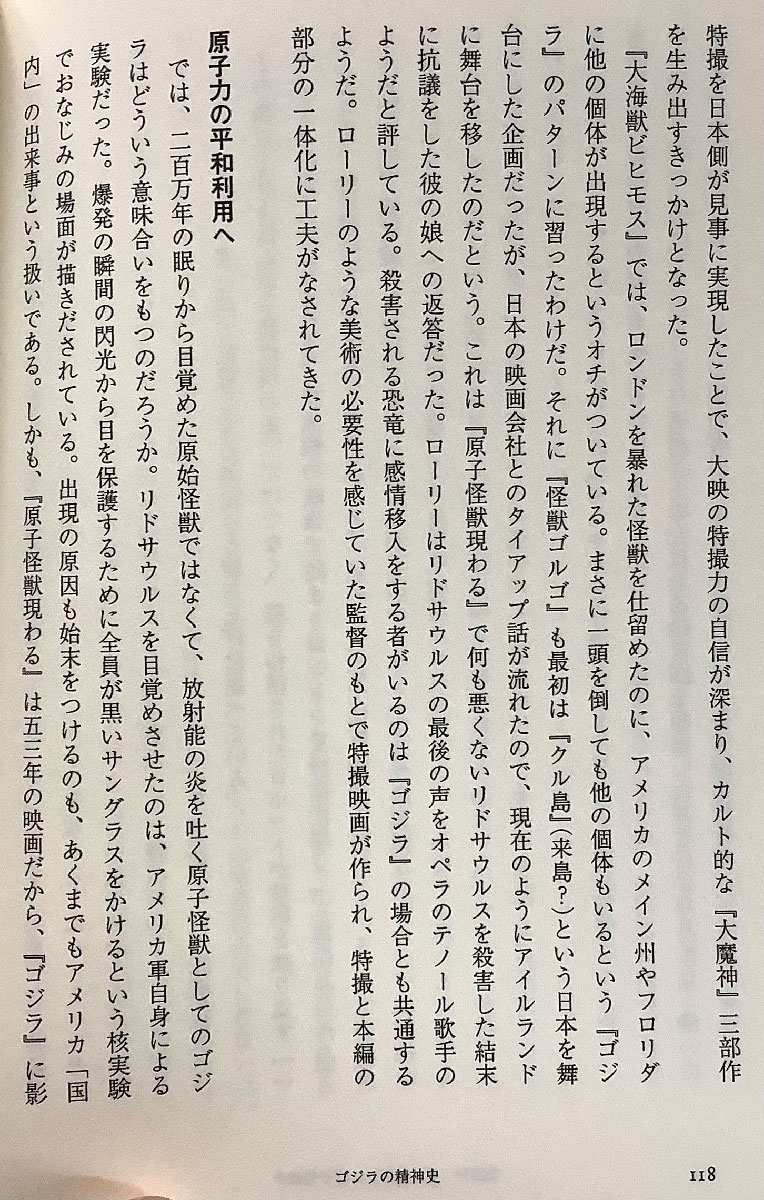5.25.2023
The Cultural History of Godzilla – Pt 45


P 115
原子怪獣を作り上げた男たち
The Men Who Created the Atomic Monster
『原子怪獣現わる』の原作にあたる「二万尋から来た獣」はレイ・ブラッドベリの短編小説である。タイトルの権利が映画会社に買い取られたので、現在は「霧笛」と改題されている。ブラッドベリがこれを着想したのは、ロサンジェルス郊外のヴェニスビーチに住んでいたときだった。そこにあった廃墟と化したローラーコースターを風が抜ける音を恐竜の声のように錯覚したことが始まりだった。
“The Beast from 20,000 Fathoms,” which is the original of “Atomic Monster Appears,” is a short story by Ray Bradbury. The rights to the title were bought by a movie company, so the title is now changed to “Foghorn.” Bradbury came up with the idea while he was living in Venice Beach, a suburb of Los Angeles. It all started with the illusion that the sound of the wind blowing through the abandoned roller coaster was like the voice of a dinosaur.

P 116
そして霧笛を仲間の声と錯覚して、深海から太古の恐竜がやってきて、灯台を襲うという話をすぐに完成させた。だから、映画の最後に関してハリーハウゼンが出したアイデアが、コニーアイランドの遊園地のローラーコースターとなったのは、むしろ物語の原点にもどった秀逸な設定といえる。
Mistaking the foghorn for the voices of his companions, he quickly completed the story of an ancient dinosaur coming from the depths of the sea and attacking the lighthouse. So, Harryhausen’s idea for the end of the movie is a roller coaster ride at Coney Island’s amusement park, which is an excellent return to the origin of the story.
二人のレイと称されるブラッドベリとハリーハウゼンとは古いSF仲間で彼らがタッグを組んだ映画となった。ハリーハウゼンは『ロスト・ワールド』や『キング・コング』で活躍したウィリス・オブライエンの事実上唯一の弟子となり、『原子怪獣現わる』で利用したのは、背後に実写の場面を映しながら、一コマずつ模型の怪獣を動かして撮影するという技法だった。これによって、その後十六本の特撮映画で活躍するのだ。『水爆と深海の怪物』(一九五五年)では水爆実験で出現した大ダコがあばれる。そして『地球2千万マイル』(一九五七年)では、巨大化する金星の生物がローマ市内を大暴れする様子を見事に構築した。その一方で、シンドバッド物のような幻想的な話での魔物や怪物の動きにも手腕を発揮した。
Bradbury and Harryhausen, known as the two Rays, are old sci-fi comrades and they teamed up for the film. Harryhausen became the de facto sole apprentice of Willis O’Brien, who played an active part in “The Lost World” and “King Kong.” It was a technique of moving a model monster frame by frame and shooting. As a result of this, he will be active in 16 special effects movies after that. In “It Came from Beneath the Sea” (1955), a large octopus that appeared in a hydrogen bomb test is rampant. And in “20 Million Miles to Earth” (1957), he created a scene in which the giant Venusian creatures rampage through the city of Rome. On the other hand, he was also proficient in demonic and monstrous movements in fantastical stories such as those of Sinbad.
だが、ハリーハウゼンはあくまでも映画の半分である立体アニメーションの特撮担当でしかない。この映画にハリーハウゼンを採用したのは、監督のユージーン・ローリーだった。日米の特撮映画の相互関係を考えるときに、ローリーの存在を忘れるわけにはいかないだろう。ローリーは、ジャン・ルノワールの『ゲームの規則』やチャップリンの『ライムライト』さらに戦争映画の『バルジ大作戦』の美術監督を務めてきた。
However, Harryhausen is only in charge of special effects for three-dimensional animation, which is half of the movie. It was director Eugene Lowry who recruited Harryhausen for the film. When considering the relationship between Japanese and American tokusatsu films, we cannot forget the existence of Raleigh. Laurie has worked as art director on Jean Renoir’s The Rules of the Game, Chaplin’s “Limelight,” and the war film “The Battle of the Bulge.”
全米監督組合によるオーラルヒストリーの企画に応じて、作品ごとの裏話を詳しく語ったものが、『映画における私の仕事』(一九八五年)という一冊の本になっている。
In response to an Oral History project by the Directors Guild of America, the detailed behind-the-scenes stories for each film were published in a book called My Work in Cinema (1985).

P 117
そのなかで、美術監督、特殊効果監督、さらには作品の監督としての工夫を語っているのだ。『原子怪獣現わる』はハリーハウゼンのストップモーションの職人技だけが注目されがちだが、撮り直しのきかない低予算のなかで、実写場面を二週間ほどの撮影期間ですませたのは監督のローリーの手腕だった。特撮用のミニチュア作りをおこない、実写との合成に光源の向きをそろえるなどのたくみな計算を発揮した。完成作をジャン・ルノワールが一緒に観て絶賛してくれた、と誇らしげに述べている。
In it, he talks about his ingenuity as an art director, a special effects director, and even a director of a work. Harryhausen’s stop-motion craftsmanship tends to attract attention in “The Beast from 20,000 Fathoms,” but it was Director Laurie who was able to complete the live-action scene in about two weeks with a low budget that could not be reshot. He made miniatures for special effects, and demonstrated skillful calculations such as aligning the direction of the light source for compositing with live action. He proudly states that Jean Renoir saw the finished work with him and admired it.
その後ローリーは「原子怪獣現わる』だけでなく、脳を移植されたロボットが殺戮を繰り返す『ニューヨークの巨人』(一九五八年)、核実験の映像で始まりロンドンを怪獣が襲う『大海獣ビヒモス』(一九五九年)、『怪獣ゴルゴ』(一九六一年)といった一連の巨人物や怪獣映画を監督している。『大海獣ビヒモス』では、核実験の放射能で変質した恐竜が、口から吐く「生物学的連鎖反応」の力で放射性のやけどを引き起こして人々を殺すのだ。フェリーを転覆させたり、ロンドンの街中を暴れまわる。この作品には『キング・コング』のウィリス・オブライエンが特撮に加わっていた。ローリーの場合、恐竜たちが四足で動くタイプなのがゴジラとの違いだし、恐竜の出現する場所として大西洋沿岸にこだわっている。
After that, Laurie not only appeared in “The Beast from 20,000 Fathoms,” but also in “The Giants of New York” (1958), in which robots with transplanted brains repeatedly slaughter, and in “The Giant Behemoth,” which begins with images of nuclear tests and monsters attacking London. He has directed a series of giants and monster movies such as “Gorgo” (1961). In “The Giant Behemoth,” a dinosaur that has been altered by radiation from a nuclear test kills people by causing radioactive burns through the power of a “biological chain reaction” that it spews from its mouth. Capsize a ferry or go on a rampage through the streets of London. Willis O’Brien of “King Kong” was involved in the special effects for this work.In the case of Laurie, the dinosaurs are the type that move on all four legs, which is different from Godzilla.
また、ローリーは大映との日米合作の『あしやからの飛行』(一九六四年)でも美術監督をつとめた。大映京都撮影所内の道にネオンをつけて東京の街のように見せたり、グラマンの内部を撮影するための機体を作り上げたり、ミニチュアセットの元になる設計図を担当したりと、かなり忙しく働いたことを回想している。ローリーが図面を引いたミニチュアセットの雪原に飛行機が不時着する場面の特撮を日本側が見事に実現したことで、大映の特撮力の自信が深まり、カルト的な『大魔神』三部作を生み出すきっかけとなった。
Laurie was also the art director for the Japanese-American co-production “Flight from Ashiya” (1964) with Daiei. He put neon lights on the streets of Daiei Kyoto Studio to make it look like the city of Tokyo, built an aircraft for filming the inside of Grumman, and was in charge of the blueprints that were the basis for miniature sets. He recalls working quite hard. The special effects of the scene in which an airplane crash-landed in a snowy field in a miniature set drawn by Raleigh was successfully realized by the Japanese side. became.

P 118
『大海獣ビヒモス』では、ロンドンを暴れた怪獣を仕留めたのに、アメリカのメイン州やフロリダに他の個体が出現するというオチがついている。まさに一頭を倒しても他の個体もいるという「ゴジラ』のパターンに習ったわけだ。それに『怪獣ゴルゴ」も最初は『クル島』(来島?)という日本を舞台にした企画だったが、日本の映画会社とのタイアップ話が流れたので、現在のようにアイルランドに舞台を移したのだという。これは『原子怪獣現わる』で何も悪くないリドサウルスを殺害した結末に抗議をした彼の娘への返答だった。ローリーはリドサウルスの最後の声をオペラのテノール歌手のようだと評している。殺害される恐竜に感情移入をする者がいるのは『ゴジラ』の場合とも共通するようだ。ローリーのような美術の必要性を感じていた監督のもとで特撮映画が作られ、特撮と本編の部分の一体化に工夫がなされてきた。
In “The Giant Behemoth,” even though he killed the monster that was rampant in London, there is a punchline that other individuals appear in Maine and Florida in the United States. He learned from the pattern of “Godzilla” that there are other individuals even if you defeat one. In addition, “Gorgo” was originally a project called “Kurushima” (Kurushima?) set in Japan, but there was talk of a tie-up with a Japanese film company, so the stage was moved to Ireland as it is now. This was a reply to his daughter who protested against the murder of the Rydosaurus, which was nothing wrong in “The Beast from 20,000 Fathoms.” Raleigh describes the final voice of Rydosaurus as being like an opera tenor. It seems that it is common to “Godzilla” that there are people who empathize with the dinosaur being killed. Special effects films were made under directors who felt the need for art like Raleigh, and efforts were made to integrate the special effects and the main part.